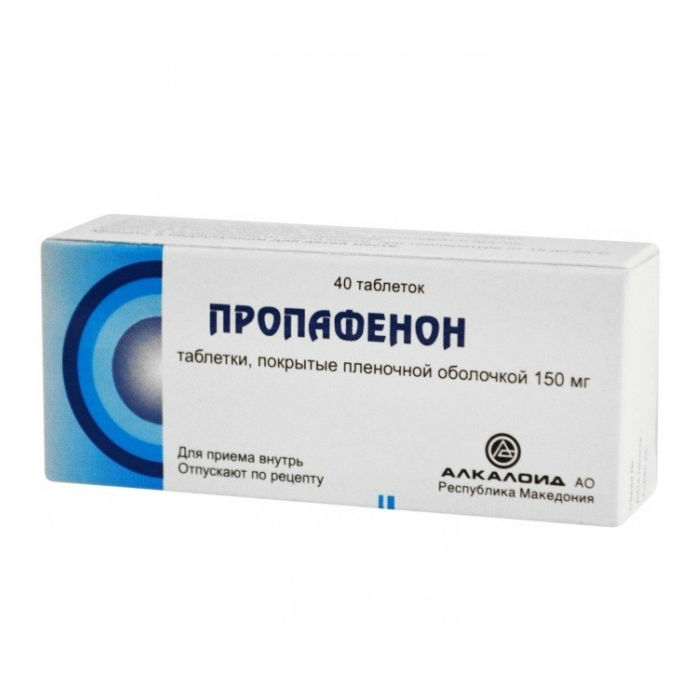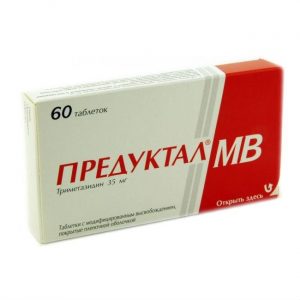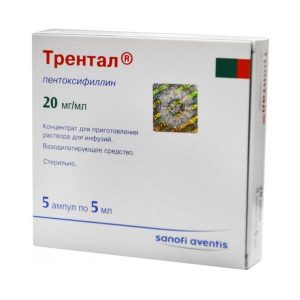Description
Release form
film-coated tablets.
Packaging
40 pcs.
Pharmacological action
Antiarrhythmic. The effect of Propafenone is based on a local anesthetic and direct membrane stabilizing effect on myocardiocytes. It has m-anticholinergic and beta-adrenergic blocking (weak) effects, blocks sodium channels.
Special instructions
Treatment should be started in a hospital setting, since there is an increased risk of arrhythmogenic effects associated with the use of propafenone. It is recommended that prior antiarrhythmic therapy be discontinued before treatment with propafenone at a time equal to 2-5 T1 / 2 of these drugs.
Treatment should be under the control of electrolyte balance (especially K + concentration) and the ECG periodically determine the activity of transaminases, antinuclear antibodies.
In the treatment of ventricular arrhythmias, propafenone is more effective than antiarrhythmic drugs of classes Ia and Ib.
In case of induced arrhythmias, an intracardiac electrophysiological study is performed no earlier than 5-7 days after the start of administration.
With ventricular extrasystole, the general rule is to reduce the number of extrasystoles by 70% from the baseline, according to Holter daily monitoring.
During the treatment period, care must be taken when driving vehicles and engaging in other potentially hazardous activities that require an increased concentration of attention and speed of psychomotor reactions.
Composition
Active ingredients: propafenone hydrochloride 150 mg
Excipients: microcrystalline cellulose – 100.6 mg, croscarmellose sodium – 14 mg, hypromellose – 11.2 mg, colloidal silicon dioxide – 1.4 mg, magnesium stearate – 2.8 mg.
Composition of the film coat: film coating Opadry II white: (polyvinyl alcohol 46.9%, macrogol 4000 – 23.6%, talc – 17.4%, titanium dioxide – 12. 1%) – 10 mg.
Dosage and administration of
Propaphenone is taken orally after meals (tablets should be swallowed whole with a little water). The dosage regimen is set individually and adjusted by the doctor: 150 mg every 8 hours (450 mg / day). The dose is increased gradually, every 3-4 days, up to 600 mg / day in 2 divided doses or up to 900 mg / day in 3 divided doses.
Side effects
From the cardiovascular system: bradycardia, AV dissociation, ventricular tachyarrhythmias, angina pectoris, worsening heart failure (in patients with reduced left ventricular function), SA and AV block, intraventricular conduction disturbances, supraventricular tachyarrhythmias when taken in high doses orthostatic hypotension.
From the digestive system: taste change, dryness and bitterness in the mouth, nausea, decreased appetite, a feeling of heaviness in epigastrium, constipation or diarrhea rarely – liver dysfunction, cholestasis, cholestatic jaundice.
From the side of the central nervous system: headache, dizziness rarely – blurred vision, diplopia, convulsions.
From the laboratory parameters: leukopenia, thrombocytopenia, agranulocytosis, an increase in bleeding time, the appearance of antinuclear antibodies.
Allergic reactions: skin rash, itching, exanthema, redness of the skin, urticaria, lupus-like syndrome.
Other: weakness, bronchospasm, hemorrhagic skin rash.
Drug interaction
Increases the plasma concentration of propranolol, metoprolol, digoxin (there is an increased risk of glycoside intoxication), indirect anticoagulants, cyclosporine. Enhances the effect of warfarin (blocks metabolism).
With simultaneous use with beta-blockers and tricyclic antidepressants, anti-arrhythmic action may be enhanced, with local anesthetics – an increased risk of central nervous system damage.
Cimetidine and quinidine, slowing the metabolism, increase the concentration of propafenone in plasma by 20%, rifampicin – reduces.
Amiodarone increases the risk of developing pirouette type tachycardia.
drugs that inhibit SA and AV nodes and have a negative inotropic effect increase the risk of side effects.
drugs that inhibit bone marrow hematopoiesis, increase the risk of myelosuppression.
Overdose
Symptoms: decreased blood pressure, drowsiness, confusion, bradycardia, impaired intra-atrial and intraventricular conduction, coma, convulsions, extrapyramidal disorders, ventricular tachyarrhythmias.
Treatment: gastric lavage, defibrillation, administration of dobutamine, diazepam if necessary – IVL and indirect cardiac massage. Hemodialysis is ineffective.
Storage conditions
At a temperature not exceeding 25 ° C.
active substance
Propafenone
Terms leave through pharmacies
In retseptu
Dosage form
tablet
Alkaloid AD Skopye, Macedonia




